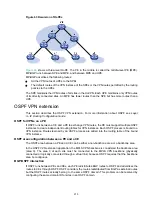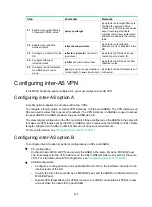
222
Configuring IBGP between a PE and a CE
Use IBGP between PE and CE only in a basic MPLS L3VPN network. In networks such as
Hub&Spoke, Extranet, inter-AS VPN, carrier's carrier, nested VPN, and HoVPN, you cannot use
IBGP between PE and CE.
1.
Configure the PE:
Step Command
Remarks
1.
Enter system view.
system-view
N/A
2.
Enter BGP instance view.
bgp
as-number
[
instance
instance-name
]
N/A
3.
Enter BGP-VPN instance
view.
ip vpn-instance
vpn-instance-name
Configuration commands in
BGP-VPN instance view are the
same as those in BGP instance
view. For more information, see
Layer 3—IP Routing
Configuration Guide.
4.
Configure the CE as the
VPN IBGP peer.
peer
{
group-name
|
ip-address
[
mask-length
] }
as-number
as-number
By default, no BGP peers exist.
5.
Create the BGP-VPN IPv4
unicast family and enter its
view.
address-family ipv4
[
unicast
]
By default, the BGP-VPN IPv4
unicast family is not created.
6.
Enable IPv4 unicast route
exchange with the
specified peer.
peer
{
group-name
|
ip-address
[
mask-length
] }
enable
By default, BGP does not
exchange IPv4 unicast routes
with any peer.
2.
Configure the CE:
Step Command
Remarks
1.
Enter system view.
system-view
N/A
2.
Enter BGP instance view.
bgp
as-number
[
instance
instance-name
]
N/A
3.
Configure the PE as an
IBGP peer.
peer
{
group-name
|
ip-address
[
mask-length
] }
as-number
as-number
By default, no BGP peers exist.
4.
Create the BGP IPv4
unicast family and enter its
view.
address-family ipv4
[
unicast
]
By default, the BGP IPv4
unicast family is not created.
5.
Enable IPv4 unicast route
exchange with the
specified peer or peer
group.
peer
{
group-name
|
ip-address
[
mask-length
] }
enable
By default, BGP does not
exchange IPv4 unicast routes
with any peer.
6.
(Optional.) Configure route
redistribution.
import-route
protocol
[ {
process-id
|
all-processes
}
[
allow-direct
|
med
med-value
|
route-policy
route-policy-name
] * ]
A CE must redistribute its routes
to the PE so the PE can
advertise them to the peer CE.
















































